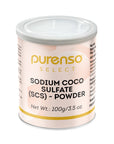
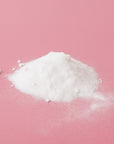
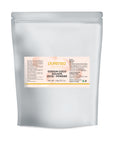
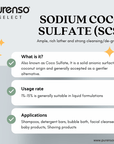
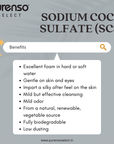
Sodium Coco Sulfate (SCS) - Powder
| Description |
Also known as Coco Sulfate, Sodium Coco Sulfate (SCS) is a solid anionic surfactant of coconut origin. It is not the same thing as Sodium Lauryl Sulfate (SLS) and is generally accepted as a gentler alternative. |
| INCI | Sodium Coco Sulfate |
| Active Surfactant Matter | 95% |
| Appearance | White Powder |
| Usage rate |
The CIR has not declared a maximum usage level for Sodium Coco Sulfate (SCS) in rinse-off products, declaring it “safe for use in rinse-off products”. It is limited to 1% in leave-on formulations (source). As Sodium Coco Sulfate (SCS) is a very effective cleanser, 1%-15% is generally suitable in liquid formulations. Solid cleansers will generally use quite a lot more as Sodium Coco Sulfate (SCS) is 3%-40% part of the solid-ness. As the CIR has not declared a maximum allowable usage level, let the performance of the formulation be your guide. |
| Applications | Shampoos, detergent bars, bubble bath, facial cleansers, baby products, Shaving products |
| Scent | Characteristically soapy/detergent |
| pH | 7.5–10.5 (1% solution) |
| Charge | Anionic |
| Solubility | Water |
| Why do we use it in formulations? | It offers fantastic, fluffy, super-abundant lather and is a strong cleanser. |
| Strengths | Ample, rich lather and strong cleansing/de-greasing. |
| Weaknesses | It is a stronger surfactant and could irritate very sensitive skin. It also has a higher pH and products made with it typically need to be adjusted. |
| How to Work with It |
Wear a dust mask! Inhaling airborne powdered surfactants is unbelievably unpleasant. You can dissolve it into the heated water phase for liquid concoctions or stir/mash the powder into blends of butters and/or other surfactants to create syndet bars. It can also be added to the powder phase of bath bombs and other bath products. |
| Benefits |
|
![]()
![]()
![]()
This product is a cosmetic raw material and is intended for external use only in cosmetic and personal care formulations. It is not intended for internal consumption or medicinal use.
- Do not ingest.
- Keep out of reach of children.
- Avoid direct contact with eyes.
All product images are for illustrative purposes only. Actual product color, texture, or packaging may vary from batch to batch.
Information provided on this website is for educational purposes only and should not be considered or interpreted as medical advice.
While we do not offer products for internal use, we source only high-quality, pharmaceutical or food-grade ingredients. Ingredient purity and performance are critical in cosmetic applications, just as they are in ingestible products.
Please note:
Just because two products have the same name or CAS number does not guarantee the same grade, purity, or effectiveness. Always choose trusted suppliers. Choose Purenso for premium-grade ingredients you can rely on.
FREQUENTLY ASKED QUESTIONS





